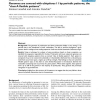44 search results - page 3 / 9 » The Distance Between Randomly Constructed Genomes |
BMCBI
2010
14 years 11 months ago
2010
Background: Phylogenetic relationships between genes are not only of theoretical interest: they enable us to learn about human genes through the experimental work on their relativ...
96
Voted
BMCBI
2005
14 years 11 months ago
2005
Background: The genomes of prokaryotes and lower eukaryotes display a very strong 11 bp periodic bias in the distribution of their nucleotides. This bias is present throughout a g...
83
Voted
IPL
2006
14 years 11 months ago
2006
We investigate the randomized and quantum communication complexity of the HAMMING DISTANCE problem, which is to determine if the Hamming distance between two n-bit strings is no l...
104
Voted
PSB
2003
15 years 1 months ago
2003
A number of biological applications require comparison of large genome strings. Current techniques suffer from both disk I/O and computational cost because of extensive memory req...
125
click to vote
JCB
2006
14 years 11 months ago
2006
We describe a novel method for efficient reconstruction of phylogenetic trees, based on sequences of whole genomes or proteomes, whose lengths may greatly vary. The core of our me...

